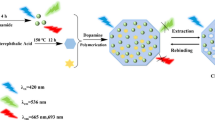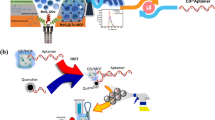Abstract
A dual-emission fluorescent (FL) probe was constructed by coordinating Cu2+ of copper metal–organic frameworks (Cu-MOFs) with − COO− group of carbon dots (CDs) for pesticide thiophanate-methyl (TM) determination. TM was recognized by organic ligands (H2BDC and H2BDC-NH2) of Cu-MOFs via π stacking. Due to the higher affinity of Cu2+ to TM than ligands and CDs, TM chelated with Cu2+ to form TM-Cu complex. Thus coordination of Cu-MOFs was damaged and the ligands were released resulting in the FL intensity increase of Cu-MOFs (F430). And also CDs were released from CDs@Cu-MOFs hybrids and electron transfer from CDs to CuMOFs was inhibited, leading to the FL intensity increase of CDs (F600). The FL intensity ratio (F430/F600) showed a good linear relationship with TM concentrations of 0.0307–0.769 μmol L−1 with a limit of detection (LOD) of ~ 3.67 nmol L−1. The probe was successfully applied to detect TM in spiked food samples with satisfactory recoveries of 93.1–113%. Additionally, visual detection of TM was achieved according to the fluorescence color variation from blue to carmine, indicating promising application of CDs@Cu-MOFs probe.
Graphical abstract






Similar content being viewed by others
References
Suresh I, Selvaraj S, Nesakumar N, Rayappan JBB, Kulandaiswamy AJ (2021) Nanomaterials based non-enzymatic electrochemical and optical sensors for the detection of carbendazim: A review. Trends Environ Anal Chem 31:e00137. https://doi.org/10.1016/j.teac.2021.e00137
Ye C, Zhou Q, Wang X (2008) Determination of thiophanate-methyl and chlorotoluron in water samples by improved single-drop microextraction coupled with high-performance liquid chromatography. Int J Environ Anal Chem 88:461–471. https://doi.org/10.1080/03067310701851864
Weis GCC, Assmann CE, Cadoná FC, Bonadiman BDSR, Alves ADO, Machado AK, Duarte MMMF, da Cruz IBM, Costabeber IH (2019) Immunomodulatory effect of mancozeb, chlorothalonil, and thiophanate methyl pesticides on macrophage cells. Ecotoxicol Environ Saf 182:09420. https://doi.org/10.1016/j.ecoenv.2019.109420
E. Commission Commission Regulation (EU) No 559/2011 of 7 June 2011 amending Annexes II and III to Regulation (EC) No 396/2005 of the European Parliament and of the Council as regards maximum residue levels for captan, carbendazim, cyromazine, ethephon, fenamiphos, thiophanate-methyl, triasulfuron and triticonazole in or on certain products Text with EEA relevance. http://data.europa.eu/eli/reg/2011/559/oj
Lee HS, Rahman MM, Chung HS, Kabir H, Yoon K-S, Cho S-K, Abd El-Aty AM, Shim J-H (2018) An effective methodology for simultaneous quantification of thiophanate-methyl, and its metabolite carbendazim in pear, using LC-MS/MS. J Chromatogr B 1095:1–7. https://doi.org/10.1016/j.jchromb.2018.07.010
Li F, Duan X, Li H, Zou L, Liu G, Liu F, Zhang G, Xu J (2022) Dual effect of aminobutyric acid group and “molecular wire effect” of conjugated polymer enables ultra-trace detection of Cr2O72− in fruits. Microchem J 178:107426. https://doi.org/10.1016/j.microc.2022.107426
Zou L, Wen Y, Zhang H, Chai J, Duan X, Shen L, Zhang G, Xu J (2018) Highly sensitive fluorescent sensor based on electrosynthesized poly(Fmoc-l-serine) enables ultra-trace analysis of Cr2O72− in water and agro-product samples. Sens Actuators, B 277:394–400. https://doi.org/10.1016/j.snb.2018.09.046
Cheng W, Tang X, Zhang Y, Wu D, Yang W (2021) Applications of metal-organic framework (MOF)-based sensors for food safety: enhancing mechanisms and recent advances. Trends Food Sci Technol 112:268–282. https://doi.org/10.1016/j.tifs.2021.04.004
Yao C-X, Zhao N, Liu J-C, Chen L-J, Liu J-M, Fang G-Z, Wang S (2020) Recent progress on luminescent metal-organic framework-involved hybrid materials for rapid determination of contaminants in environment and food. Polymers 12. https://doi.org/10.3390/polym12030691
Jiang J, Li S, Yan Y, Fang M, Chen M, Peng K, Nie L, Feng Y, Wang X (2017) Pendant structure governed the selectivity of Pd2+ using disubstituted polyacetylenes with sulfur functions and the application of thiophanate-methyl detection. Sens Actuators, B 247:36–45. https://doi.org/10.1016/j.snb.2017.03.008
Wang S, Chen H, Xie H, Wei L, Xu L, Zhang L, Lan W, Zhou C, She Y, Fu H (2021) A novel thioctic acid-carbon dots fluorescence sensor for the detection of Hg2+ and thiophanate methyl via S-Hg affinity. Food Chem 346:128923. https://doi.org/10.1016/j.foodchem.2020.128923
Han Y, Yang W, Luo X, He X, Yu Y, Li C, Tang W, Yue T, Li Z (2019) Cu2+-triggered carbon dots with synchronous response of dual emission for ultrasensitive ratiometric fluorescence determination of thiophanate-methyl residues. J Agric Food Chem 67:12576–12583. https://doi.org/10.1021/acs.jafc.9b04720
Yang Q, Wang J, Chen X, Yang W, Pei H, Hu N, Li Z, Suo Y, Li T, Wang J (2018) The simultaneous detection and removal of organophosphorus pesticides by a novel Zr-MOF based smart adsorbent. J Mater Chem A 6:2184–2192. https://doi.org/10.1039/C7TA08399H
Ma J, Wu G, Li S, Tan W, Wang X, Li J, Chen L (2018) Magnetic solid-phase extraction of heterocyclic pesticides in environmental water samples using metal-organic frameworks coupled to high performance liquid chromatography determination. J Chromatogr A 1553:57–66. https://doi.org/10.1016/j.chroma.2018.04.034
Xing S, Janiak C (2020) Design and properties of multiple-emitter luminescent metal–organic frameworks. Chem Commun 56:12290–12306. https://doi.org/10.1039/D0CC04733C
Chen L, Liu D, Peng J, Du Q, He H (2020) Ratiometric fluorescence sensing of metal-organic frameworks: tactics and perspectives. Coord Chem Rev 404:213113. https://doi.org/10.1016/j.ccr.2019.213113
Mousavi A, Zare-Dorabei R, Mosavi SH (2021) Sensitive detection of tamsulosin hydrochloride based on dual-emission ratiometric fluorescence probe consisting of amine-carbon quantum dots and rhodamine B. Sci Rep 11:20805. https://doi.org/10.1038/s41598-021-00363-x
Dong M-J, Zhao M, Ou S, Zou C, Wu C-D (2014) A luminescent Dye@MOF platform: emission fingerprint relationships of volatile organic molecules. Angew Chem Int Ed 53:1575–1579. https://doi.org/10.1002/anie.201307331
Mousavi A, Zare-Dorabei R, Mosavi SH (2020) A novel hybrid fluorescence probe sensor based on metal–organic framework@carbon quantum dots for the highly selective detection of 6-mercaptopurine. Anal Methods 12:5397–5406. https://doi.org/10.1039/D0AY01592J
Jalili R, Khataee A, Rashidi M-R, Luque R (2019) Dual-colored carbon dot encapsulated metal-organic framework for ratiometric detection of glutathione. Sens Actuators, B 297:126775. https://doi.org/10.1016/j.snb.2019.126775
Saboorizadeh B, Zare-Dorabei R, Shahbazi N (2021) Green synthesis of carbon quantum dots and their application as a fluorometric sensor for highly selective determination of 6-mercaptopurine in biological samples. J Taiwan Inst Chem Eng 129:389–395. https://doi.org/10.1016/j.jtice.2021.09.015
Shahbazi N, Zare-Dorabei R (2019) A novel “off-on” fluorescence nanosensor for sensitive determination of sulfide ions based on carbon quantum dots and gold nanoparticles: central composite design optimization. Microchem J 145:996–1002. https://doi.org/10.1016/j.microc.2018.12.022
Bao J, Mei J, Cheng X, Ren D, Xu G, Wei F, Sun Y, Hu Q, Cen Y (2021) A ratiometric lanthanide-free fluorescent probe based on two-dimensional metal-organic frameworks and carbon dots for the determination of anthrax biomarker. Microchim Acta 188:84. https://doi.org/10.1007/s00604-021-04701-8
Li B, Suo T, Xie S, Xia A, Ma Y-J, Huang H, Zhang X, Hu Q (2021) Rational design, synthesis, and applications of carbon dots@metal–organic frameworks (CD@MOF) based sensors. TrAC, Trends Anal Chem 135:116163. https://doi.org/10.1016/j.trac.2020.116163
Gupta NK, Kim S, Bae J, Soo Kim K (2021) Fabrication of Cu(BDC)0.5(BDC-NH2)0.5 metal-organic framework for superior H2S removal at room temperature. Chem Eng J 411:128536. https://doi.org/10.1016/j.cej.2021.128536
Qu S, Zhou D, Li D, Ji W, Jing P, Han D, Liu L, Zeng H, Shen D (2016) Toward efficient orange emissive carbon nanodots through conjugated sp2-domain controlling and surface charges engineering. Adv Mater 28:3516–3521. https://doi.org/10.1002/adma.201504891
Zheng M, Wang Y, Wang C, Wei W, Ma S, Sun X, He J (2018) Silver nanoparticles-based colorimetric array for the detection of Thiophanate-methyl. Spectrochim Acta, Part A 198:315–321. https://doi.org/10.1016/j.saa.2018.03.038
Zhou H, Zhang L, Wang G, Zhang Y, Wang X, Li M, Fan F, Li Y, Wang T, Zhang X, Fu Y (2021) Fabrication of 2D metal–organic framework nanosheets with highly colloidal stability and high yield through coordination modulation. ACS Appl Mater Interfaces 13:39755–39762. https://doi.org/10.1021/acsami.1c11373
Li X, Zhou H, Qi F, Niu X, Xu X, Qiu F, He Y, Pan J, Ni L (2018) Three hidden talents in one framework: a terephthalic acid-coordinated cupric metal–organic framework with cascade cysteine oxidase- and peroxidase-mimicking activities and stimulus-responsive fluorescence for cysteine sensing. J Mater Chem B 6:6207–6211. https://doi.org/10.1039/C8TB02167H
Stawowy M, Jagódka P, Matus K, Samojeden B, Silvestre-Albero J, Trawczyński J, Łamacz A (2020) HKUST-1-supported cerium catalysts for CO oxidation. Catalysts 10. https://doi.org/10.3390/catal10010108
Li C, Zhang X, Wen S, Xiang R, Han Y, Tang W, Yue T, Li Z (2020) Interface engineering of zeolite imidazolate framework−8 on two-dimensional Al−metal−organic framework nanoplates enhancing performance for simultaneous capture and sensing tetracyclines. J Hazard Mater 395:122615. https://doi.org/10.1016/j.jhazmat.2020.122615
Zhang X, Chen C, Peng D, Zhou Y, Zhuang J, Zhang X, Lei B, Liu Y, Hu C (2020) pH-Responsive carbon dots with red emission for real-time and visual detection of amines. J Mater Chem C 8:11563–11571. https://doi.org/10.1039/D0TC02597F
He X, Han Y, Luo X, Yang W, Li C, Tang W, Yue T, Li Z (2020) Terbium (III)-referenced N-doped carbon dots for ratiometric fluorescent sensing of mercury (II) in seafood. Food Chem 320:126624. https://doi.org/10.1016/j.foodchem.2020.126624
Lee KJ, Lee YU, Fages F, Ribierre J-C, Wu JW, D’Aléo A (2018) Blue-shifting intramolecular charge transfer emission by nonlocal effect of hyperbolic metamaterials. Nano Lett 18:1476–1482. https://doi.org/10.1021/acs.nanolett.7b05276
Jiao L, Dong D, Zheng W, Zhao X, Zhang S, Shen C (2014) Determination of thiophanate-methyl using UV absorption spectra based on multiple linear regression. Optik 125:183–185. https://doi.org/10.1016/j.ijleo.2013.06.012
Funding
This work was financially supported by the Social Development Grant of Shaanxi Province (2022NY-037), National Natural Science Foundation of China (No. 32060571) and West Light Foundation of the Chinese Academy of Sciences (21JR7RM186).
Author information
Authors and Affiliations
Contributions
Ying Yu: methodology, data curation, writing—original draft. Gengli Huang: methodology, review and editing. Xueli Luo: methodology. Wanmei Lin: review and editing. Yong Han: software. Jihong Huang: methodology. Zhonghong Li: methodology, writing—review and editing.
Corresponding authors
Ethics declarations
Conflict of interest
The authors declare no competing interests.
Additional information
Publisher's note
Springer Nature remains neutral with regard to jurisdictional claims in published maps and institutional affiliations.
Supplementary Information
Below is the link to the electronic supplementary material.
Rights and permissions
Springer Nature or its licensor holds exclusive rights to this article under a publishing agreement with the author(s) or other rightsholder(s); author self-archiving of the accepted manuscript version of this article is solely governed by the terms of such publishing agreement and applicable law.
About this article
Cite this article
Yu, Y., Huang, G., Luo, X. et al. Carbon dots@Cu metal–organic frameworks hybrids for ratiometric fluorescent determination of pesticide thiophanate-methyl. Microchim Acta 189, 325 (2022). https://doi.org/10.1007/s00604-022-05438-8
Received:
Accepted:
Published:
DOI: https://doi.org/10.1007/s00604-022-05438-8




